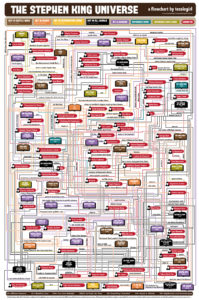Emmeche took a scientific approach towards describing complexity in life sciences in his article named “Aspects of Complexity in Life and Science”. Reflecting back from past experience, complex problems will require a complex solution and in turn, may result in a complex system. Complex systems are different than a complicated system although they are usually confused with each other. Complex systems are integrated and interconnected within and around many parts, where are complicated are intricate, convoluted.

Stephen King’s Universe, Available at http://www.coolinfographics.com/blog/2013/5/16/the-stephen-king-universe.html
We as architects always strive for simplicity. The simplicity at each component, simplicity at each interaction is something that makes a complex system successful. Intricacy at the component and interaction level makes a simple or a complex system a complicated system.
It is very interesting when I read “Complex systems are often hierarchic (Pattee 1973 1, Allen and Star 1982 2)” , the idea is clear and consistent with what we solve with EA modeling. Even a natural system “computes” next state in an algorithmic fashion, very similar to computers, where laws of nature correspond to algorithms of a computer program (Emmenche 1997 3). The degree of complexity can be measured by the logical depth of the structure (system in this case) (Bennett 1986 4).
EA modeling demonstrates complexity by presenting context based representation of system/problem abstraction for making decisions. EA modeling allows assessment of interrelated entities in an abstraction (Contextual, Conceptual, Logical, and Physical) in the manner that is relevant to consumer i.e. practitioners, stakeholders etc. The practicality of EA modeling depends on technique and used for simplification within the provided context to improve understanding of components and their interactions at level of abstraction needed. Considering system abstractions as mentioned by Bennett are merely degrees of logical depth, and hierarchy is another characteristic of complexity, EA modeling can facilitate decision making in a hierarchical manner (top down or bottom up) reducing the need for looking at entire solution/problem as whole at a time or at level granularity unnecessary. Solving problems or generating understanding can happen smaller chunks and can be related and always remain relevant to a larger system.
References
- Pattee, H.H. (1973), Hierarchy Theory. The challenge of complex systems. New York: George Braziller.
- Allen, T.F.H. and T.B. Starr (1982): Hierarchy. Perspectives for Ecological Complexity. Chicago: The University of Chicago Press.
- Emmenche, 1997, Aspects of Complexity in Life and Science, Philosophica vol. 59, 1997 (1), pp. 41-68 edited by Braeckman, J
- Bennett, C.H. (1986), `On the nature and origin of complexity in discrete, homogeneous, locally interacting systems’, Foundations of Physics 16 (6), 585-592.
